Power-System Reliability Impact of Energy-Storage Integration with Intelligent-Operation Strategy
Yixing Xu Intellectual Ventures
Abstract
Electric power industry is experiencing a critical movement from the existing conventional electric grid to a more reliable, efficient and secure smart grid. In order to achieve these goals, components such as large scale energy storage will be included. Many feasible applications of energy storage in power systems have been investigated. The major benefits of energy storage include electric energy time-shift, frequency regulation and transmission congestion relief. In this chapter, the focus is on the reliability improvement of the bulk power system brought by the utilization of energy storage in the local distribution systems integrated with renewable energy generation. Operation strategies for flexible energy storage device are critical to the reliability and economic performance of the power system. An intelligent operation strategy for energy storage which improves reliability considering the renewable energy integration is presented. The framework of the smart grid communication and control network is utilized to implement the proposed energy storage operation. A bulk power system reliability evaluation framework is proposed to study the reliability impact brought by the energy storage integration and operation.
Nomenclature
C(k) Power charged to energy storage in period k
CMax Energy storage maximum charging power limit
D(k) Power discharged from energy storage in period k
DMax Energy-storage maximum discharging power limit
L(k) Load in current period k
Lf (k) Forecasted load in future period k
P(k) Energy price for period k
Pf (k) Forecasted energy price for future period k
R(k) Utilized renewable energy in period k
Rf (k) Forecasted renewable energy utilization in period k
RMax(k) Available renewable energy in period k
Rf,Max(k) Forecasted available renewable energy in period k
U(k) Energy purchased in power market for period k
Uf (k) Energy planned to be purchased in future period k
SOC(k) State-of-charge level at the end of period k
SOCMin Energy-storage minimum state-of-charge level
SOCMax Energy-storage maximum state-of-charge level
ηc Energy-storage charging efficiency
ηd Energy-storage discharging efficiency
1. Introduction
In the environment of smart grids, new infrastructure and technologies are put into place to facilitate better information flow and communication between all stakeholders in the system, including generation entities, system operators, market participants, and distribution system load aggregators [1]. By taking advantage of the communication network, useful local data collected within distribution systems and global data held by system operators can be sent and received from each entity in a timely fashion. With the comprehensive and timely data and information, participants in the power system can make better decisions to improve their own and the system’s reliability and economy. In this chapter, energy-storage devices are operated with an intelligent strategy, which fully utilizes the data and information received to make charging or discharging decisions in order to improve both of the economy of the local-distribution system and the bulk-power system reliability. Considering the higher penetration of renewable-energy generation [2], the distributed renewable-energy resources, such as wind and solar generation, integrated in distribution systems are also considered.
With the rapid development of energy-storage technologies including batteries and other forms, and their control flexibility during operation, interest in integrating energy storage into power systems to improve systems reliability and economy has been growing. A reliability cost/worth evaluation method is presented in [3]. The authors in [4] evaluate system reliability considering both wind- and hydro-power coordination. A methodology for the operation of a hybrid plant with wind power and hydrogen storage to maximize economic benefits is presented in [5]. Researchers in [6–8] investigated the operation strategies of energy storage on the bulk-power system level and evaluated the reliability impact.
Previous reported work has been mainly on the operations of energy storage and renewable energy at the bulk-power system level and on evaluating the corresponding reliability impact. Currently, the trend is on increasing the amount of energy-storage devices that are being integrated into distribution systems and used to support the distribution-system operations. For example, in a smart-grid demonstration project funded by the U.S. Department of Energy, the community energy storage is deployed at DTE Energy to benefit consumers, businesses, and utilities [9]. When energy storage is operated to benefit the distribution system, it can also be intelligently coordinated by the system operator to have a positive impact on the bulk-power system. The smart-grid communication and control network make the intelligent-operation strategies possible, which require real-time information and control-signal communication between multiple entities. This chapter focuses on the reliability impact on the bulk-power system, considering the energy-storage operation strategies within the distribution system and the coordination of the bulk-power system operator. The energy-storage operation strategy for a distribution system load aggregator is presented to improve the economy of distribution system by minimizing the energy-purchasing cost in the power market. An energy-storage coordination strategy for system operator is proposed to improve bulk-power system reliability, taking into consideration the local energy-storage operations. In order to accurately quantify the reliability impact brought by energy storage, a reliability evaluation framework is presented. The reliability impact of energy storage is then studied and insights are gained.
This chapter is organized as follows: Section 2 describes the energy-storage operation strategy for distribution systems. Section 3 presents the energy-storage coordination strategy when there is a loss-of-load event. Section 4 describes the proposed reliability evaluation framework, taking into consideration the energy-storage operation and coordination. Case studies and insights are presented in Section 5, and the conclusion is presented in Section 6.
2. Energy-storage operation strategy in a distribution system
In many deregulated electricity markets, small individual customers located in a distribution system normally do not directly participate in the wholesale market to purchase the energy they need. Instead, a load aggregator is an entity that participates in the wholesale power market, and purchases the energy for its individual customers and delivers the power to them.
Normally, load at a given time is determined by customers’ demand and is generally considered as inelastic to price except considering demand response. Considering the relatively small scale of the demand-response program and the scope of this work, such demand-response programs are not considered. The load is assumed to be determined by customers and inelastic.
In a market environment, a load aggregator’s objective is to serve its customers reliably, while minimizing cost in the wholesale power market. With the integration of energy-storage devices, a load aggregator has more flexibility in managing energy transaction and delivery, which can lead to more cost savings and reliability improvement.
The distribution-network topology with energy storage and distributed renewable energy is simplified as shown in Figure 8.1. All the loads, energy-storage devices, and distributed renewable-energy resources within this distribution system are modeled as aggregated components for simplicity. However, more detailed modeling, such as distributed modeling along the feeders and the distribution network topology, can also be used. The load in each period k, L(k), is inelastic as described above. The energy storage can be charged with the power purchased in the power market and delivered from the external grid. The energy storage can also be discharged to support the load L(k). The charging power C(k) and discharging power D(k) of energy storage are controlled by the load aggregator. The charging and discharging efficiencies are considered, and a more detailed energy-storage model can be used according to specific needs. Distributed renewable energy generation provides power R(k) to the distribution system. Imported power U(k) is the power purchased in the power market and delivered through an external grid in each period k. If power is allowed to be sold back to the external grid, U(k) can be negative, which means power flows from the distribution system to the external grid. This operation can occur when there is excessive power generated from the distributed generation integrated in the distribution system. During each period k, the energy is balanced with the load, distributed renewable-energy generation, energy-storage charging /discharging power, and the imported power. The load aggregator of a distribution system participates in the wholesale power market to purchase electric energy to serve its customers. Additionally, the load aggregator is also assumed to have the capability to operate the renewable-energy generation and energy storage integrated into its served distribution system. Renewable-energy generation can be controlled by curtailing its renewable energy output. Energy-storage devices are operated by determining the charging/discharging operations. The objective of the load aggregator is to serve its customers with a reliable power supply while minimizing the electric-energy purchasing cost in the power market. In this study, only the active power is considered. The power loss is not considered. Voltage levels are assumed to be properly regulated. These assumptions are normally acceptable in reliability analysis.
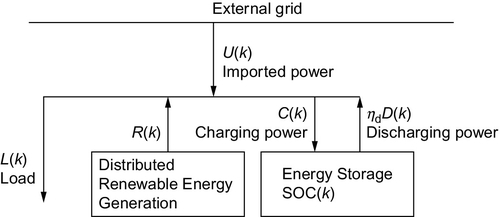
2.1 Modes of Operation
The load aggregator of the distribution system has more flexibility during operation with integrated energy storage and distributed renewable-energy generation. It can utilize flexible control of the energy storage to adjust the purchased or imported power from the power market and manage the renewable-energy generation. Considering the component failures and congestions in the bulk-power and distribution systems, the distribution system with renewable-energy generation and energy storage are operated in the following four modes: grid-connected mode, coordination mode, islanding mode, and failure mode.
Operation Strategy in Grid-Connected Mode: In grid-connected mode, there is no fault within the distribution system; the external grid can deliver the required power to the distribution system. In this mode, power from the external grid, renewable-energy generation, and energy storage can all be utilized to serve the load. The objective of the load aggregator is to minimize its energy-purchasing cost in the power market while meeting the demand.
In the environment of a smart grid, new infrastructure and technologies are put into place to enhance the information flow and communication between all stakeholders in the system. By taking advantage of the communication network, useful data and information can be sent and received from each entity in a timely fashion. With this comprehensive and timely data and information, load aggregators can make better decisions to achieve cost-saving goals. Energy-storage devices are operated with an intelligent strategy that fully utilizes the data and information received to make operation decisions in order to improve the economy of the local distribution system. A model predictive control (MPC)-based operation strategy is presented to minimize the energy-purchasing cost by optimally coordinating the energy purchase from the power market, energy-storage charging/discharging operation, and utilization of renewable-energy generation.
The power market is simplified as a real-time power market model. During each market period (e.g., 5 minutes or 15 minutes), the amount of energy needed is determined by the load aggregator. Then it submits its offer to get the needed amount of energy in the market. The energy price is determined by the market-clearing mechanism and the load aggregator is assumed to be a price-taker. Thus, the energy purchasing cost for N periods starting from period i + 1 is:

The energy-storage unit is modeled by its operation limits, which include the energy-storage maximum and minimum state-of-charge (SOC) level, charging/discharging power limit, and charging/discharging efficiency. The SOC at the end of each period is determined by the previous period SOC level and the charging/discharging operation during this period. It is expressed as:
![]()
All energy-storage operation variables are within their operation limits.
Numerous effective methods have been developed for load forecasting [10,11], renewable-energy forecasting [12,13], and energy-price forecasting [14–16]. The load aggregator can utilize these techniques to derive short-term forecasts of load, available renewable energy, and energy price to determine the operation.
The basic procedure of MPC is that a finite-horizon optimization problem determining the series of optimal operations is solved before each operation step, but only the first control operation is implemented [17]. After implementing the first step, the system updates the actual state of the system and the future states using a predictive model. Then the routine is repeated to determine the next step’s operation. Applying the above MPC approach, the energy-purchasing cost minimization problem at period i can be implemented as follows:
1. Obtain the actual load, available renewable energy, and price in the current period i.
2. Select a receding optimization horizon of N periods (e.g., 24 hours). Use load, renewable energy, and price-forecast models to obtain the most updated load, renewable energy, and price forecasts for the next N periods, from period i + 1 to i + N.
3. Solve the optimization problem, formulated as follows.
Objective: Minimizing energy-purchasing cost from period i to i + N.

The first part U (i) ⋅ P (i) is the energy-purchasing cost of the current period i. The second part  is the predicted total energy- purchasing cost of the following periods from i + 1 to i + N. U (i) and Uf (k) are the decision variables to be solved.
is the predicted total energy- purchasing cost of the following periods from i + 1 to i + N. U (i) and Uf (k) are the decision variables to be solved.
Constraints:
Energy-storage operation constraints

where k = i,i + 1,…,i + N.
Available renewable-energy constraints

where k = i + 1,…, i + N. The utilized renewable energy is equal to or less than the available renewable energy. Extra energy is curtailed according to the operation constraints. For example, by controlling the pitch angle of the blades of a wind turbine, the wind-power output can be curtailed [18].
Power-balance constraints

where k = i + 1,…,i + N. Load, available renewable energy, and price in current period i are the actual values and are known. While load, available renewable energy, and price in future periods are predicted using forecast models and thus are given parameters for the optimization problem. The solution of this optimization problem gives an optimal operation schedule for energy-storage charging/discharging operation, energy purchase, and renewable-energy utilization from period i to i + N.
4. Implement the first period’s operation of the solved operation schedule, which is the current period i.
5. Update the energy-storage SOC level, move to the next period, and repeat the algorithm from step 1.
The short-term (e.g., next 2-3 hours) forecast is relatively more accurate than the longer-term (e.g., 23-24 hours) forecast. The load, renewable-energy, and price forecasts are updated according to the newest information after each operation step. Then the most updated forecasts can be effectively integrated into the operation decision-making process to minimize the energy-purchasing cost. Better operation for the current period can be determined by taking the future load, renewable energy, and price into consideration.
The solution for the energy-storage operation schedule is only optimal with respect to the given forecast. Thus, the accuracy of the forecast will affect the optimality of the actual operation schedule, because of the errors between the forecast and the actual values, such as wind-power output. In the case study, we have assumed the forecast to be perfect, but if information on characteristics of forecast uncertainty were available, it could be considered in the determination of the operation schedule. The proposed MPC-based operation strategy can significantly mitigate the negative impact caused by the forecast errors. The reason is that this strategy constantly updates the forecasts, and utilizes the most accurate short-term forecasts to determine the current operation. The detailed study regarding the impact brought by the forecast errors can be found in [19].
The structure of the communication and control network supporting the operation strategy is presented in Figure 8.2. As shown in Figure 8.2, the load aggregator utilizes the smart-grid communication and control network to receive real-time updated information, determine the operation schedule, and execute the operations. The received information includes energy-price forecast, energy-storage SOC, load forecast, and renewable-energy forecast. With the forecast information, the load aggregator can use the MPC-based operation strategy to determine the operations, which include transactions in the power market, energy-storage charging/discharging operations, and renewable-energy curtailment.
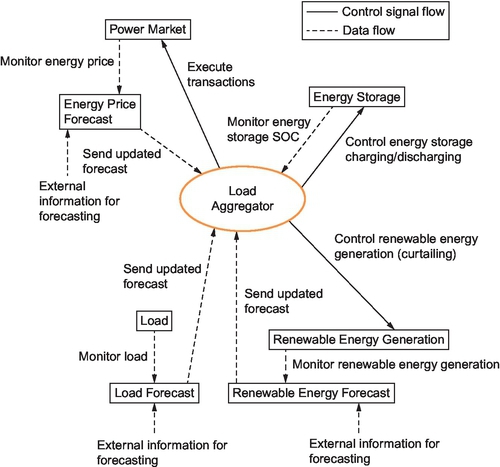
Operation Strategy in Coordination Mode: When the distribution system is operated in grid-connected mode, failures can occur in the bulk-power system. These failures can cause loss of load in some demand nodes. The bulk-power system operator can utilize the energy-storage resources in certain distribution systems to avoid some of the loss-of-load events. This operation mode requires coordination between the local distribution system load aggregator and the bulk-power system operator. Details of this energy-storage coordination operation strategy are presented in Section 3.
Operation Strategy in Islanding Mode: In islanding mode, the external grid can not deliver power to the distribution system due to failures in the external grid. The objective of the load aggregator is avoiding or minimizing load curtailment. The available renewable energy is first utilized to serve the load. If it is not enough to cover the load, energy storage is discharged to support the load. If there is extra renewable energy, it is stored in energy storage for future use. The extra energy that cannot be stored in energy storage due to operation constraints is dumped.
Failure Mode: In this mode, there is a failure inside the distribution system. Power cannot be supplied from either the external grid or from the power sources within the distribution system until the failure is cleared.
2.2 Energy-Storage Operation Impact on the Distribution-System Economic Performance
The operation of energy storage can improve both the reliability level and the economic performance of distribution systems. With the MPC-based operation strategy, the distribution system can obtain considerable economic benefits by optimally controlling the energy-storage charging/discharging operation. Detailed analysis regarding the economic impact of the energy-storage operation can be found in our previous work dedicated to this topic [20]. Due to the focus of this chapter, the following sections will focus on the reliability impact of the bulk-power system through the energy-storage coordination.
3. Energy-storage coordination
The energy storage integrated in the distribution system can not only improve the local distribution-system economy but also contribute to the bulk-power system reliability improvement. During the energy-storage operation in grid-connected mode, there is a certain amount of electric energy stored. The real-time updated energy-storage SOC information is sent to the load aggregator. When a communication channel between a distribution system load aggregator and the bulk-power system operation is established, this real-time energy-storage SOC information can be also sent to the system operator. As the system operator has the information from the bulk-power system, it can coordinate the power supplies and use the energy storage integrated in the distribution system to support part of the bulk-power system’s load if there is a loss-of-load event occurring somewhere in the system.
An unexpected outage of several generation units or simultaneous failures of several major transmission lines can cause insufficient generation for the system or transmission congestion. In either case, loss-of-load events can occur in the system. In this situation, the system operator can analyze the energy-storage SOC information that has already been collected from the load aggregators and determine whether and how to discharge the energy storage in order to avoid the loss of load or reduce the unserved energy, which subsequently leads to higher bulk-power system reliability. The coordination procedures during loss-of-load events are as follows:
1. Identify the loss-of-load event.
2. Obtain the updated available energy-storage SOC in the system. Only the energy storage operated in the grid-connected mode can be utilized by the system operator. During loss-of-load event, the operations required by the system operator have higher priority over the operations required by the load aggregator. During other periods, the load aggregator fully controls their energy-storage operation.
3. Assess the available energy and power from energy storage for a period (e.g., 5 minutes or one hour). Due to the limited stored energy, energy storage can only provide certain power output for a limited period of time.
4. Treat the energy storage as an extra power source with the assessed power from step 3.
5. Run power-flow analysis to determine the optimal dispatch with energy storage in order to avoid the loss-of-load event and prevent the system from going to a failure state. If there is still not enough energy to cover the entire load, the system is in a failure state. However, even when the system is in a failure state, the energy storage still provides its stored energy to minimize the amount of unserved energy for the studied period.
6. Send the operation instructions to the energy storage and execute the operations for this period.
7. The load aggregator updates the energy-storage SOC.
8. Go to step 2 until the system is restored to the normal state.
The real-time information enables the coordination of the energy-storage operation between the local distribution-system load aggregator and the bulk-power system operator. This coordinated operation eventually benefits both the local distribution-system load aggregators through energy cost savings and the system operator with higher bulk-power system reliability.
4. Reliability-evaluation framework
In order to quantitatively evaluate and study the reliability impact on the system brought by the energy-storage integration, a reliability evaluation framework is presented. Within this framework, the detailed energy-storage operation strategies are simulated to truly reflect its impact on the power system. In this way, the reliability impact on the bulk-power system caused by local energy-storage integration in the distribution system can be accurately evaluated. The reliability indices are valuable for the system operator when studying the energy-storage integration impact, planning for further energy-storage integration or expansion, evaluating the reliability and economic benefits, and conducting cost/worthy analysis.
The proposed reliability-assessment framework is based on sequential Monte Carlo simulation. In the reliability assessment, a power system is considered to be operating in either a success state or failure state. A system is considered operating in a success state when it has enough generation capacity to serve the load. When the generation capacity is not sufficient to meet the load demand and loss of load occurs, the system is in a failure state. The probabilities and durations associated with the system residing in success and failure states and energy not served during failure states are the reliability indices.
During operation, energy storage can serve as generation-providing power to the load and can be charged as a load. The energy-storage SOC level of the current period is determined by the previous and current operations. Because of this unique chronological characteristic of energy storage, its impact on system reliability is best captured using the sequential Monte Carlo method. The assessment flowchart is shown in Figure 8.3, and details of the assessment framework are presented as follows.
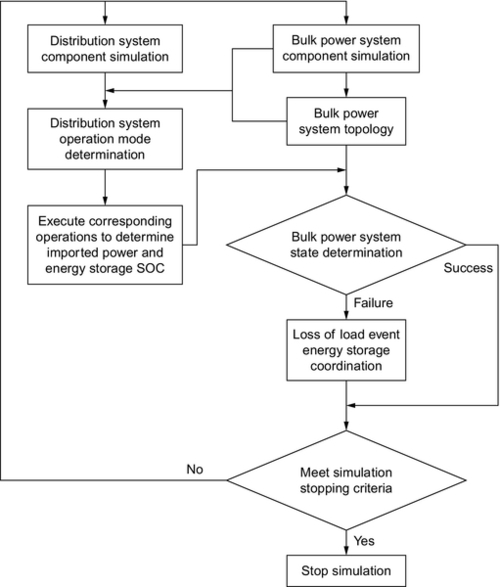
The bulk-power system and the distribution system integrated with energy storage and renewable-energy generation are simulated in parallel. The state of each bulk power system component is simulated first. With the information of the system topology and the simulated distribution-system components’ state, the operation mode of the distribution systems integrated with the energy storage and renewable-energy generation is determined. Then the energy-storage operation strategies and the distribution and transmission coordination strategies are implemented during the simulation process. According to the determined operation strategy, the energy-storage SOC and the imported power from the external grid for this distribution system are obtained. The SOC can be used by the system operator if there is a loss-of-load event in the bulk-power system. From the system operator’s point of view, the imported power for this distribution system is the load at this bus. With the load at each bus known and the knowledge of the bulk-power system components’ state and topology, power-flow analysis is performed to determine the bulk-power system state. The system is in a success state if all the loads are met; the system is in a failure state if a loss-of-load event occurs. Within the analysis, both the generation- and transmission-line availability are considered. Transmission-line congestions can also be included in the power-flow analysis. If the system is in a failure state, an energy-storage coordination strategy is applied to avoid or minimize the loss of load. During the simulation period, the system state and energy-storage SOC are updated and recorded for further simulation.
From the distribution system point of view, the system-state determination for reliability analysis is as follows:
• Under grid-connected mode, the distribution systems with energy-storage devices are connected to the external grid. The bulk-power system power-flow analysis is performed to determine whether the system load is covered by the generation and energy storage. If the total power supply is not sufficient for the entire load, or the transmission congestions cause loss of load in any part of the system, the system is identified as in a failure state. Otherwise, it is in a success state.
• Under islanding mode, the distribution systems are disconnected from the external grid. The load in the distribution systems is supported only through the integrated distributed generation and energy storage. In order for the system to be in a success state, there must be a sufficient power supply integrated into the disconnected distribution systems to cover their load, and the power-flow analysis must confirm that the load in the external grid is also covered. Otherwise, the bulk-power system is in a failure state.
• Under coordination mode, the bulk-power system requires extra energy from the distribution systems integrated with energy-storage devices in order to avoid a loss-of-load event. If there is sufficient energy from the energy-storage devices to cover the potential loss of load in the external grid, the system is in a success state. If there is not enough energy from energy storage to support the bulk-power system due to the limited stored energy or transmission congestions, the bulk-power system is in a failure state.
• Under failure mode, there is a failure inside the distribution system. Power from either the external grid or the energy storage cannot cover the distribution systems load due to either the limited energy or the distribution systems network disconnection.
Once the bulk-power system state is determined, it is recorded for this period and used to calculate the LOLP) and expected energy not served (EENS) later on. With this reliability evaluation framework, the reliability impact by the energy storage can be not only qualified but also quantified. The reliability impact from the energy storage can be attributed to two main factors. The first one is that in a loss-of-load event, energy storage can provide extra energy to the system to avoid the event or reduce the unserved energy. The other one is that because of the correlation between the energy price and load demand, the presented operation strategy controls the energy storage in a way that energy storage is charged during non-peak periods, which are also the low-energy price periods, while discharged during peak and high-energy price periods. This characteristic indicates that the distribution system’s load is adjusted to a lower level during peak periods when loss of load is more likely to occur. Thus, the total system’s peak load is mitigated. The probability of inadequate generation during the peak-load periods is reduced. The bulk-power system reliability is improved.
5. Case study
A detailed case study on a IEEE reliability test system (24 buses) [21] is performed to demonstrate the effectiveness of the proposed power-system reliability evaluation framework and the benefits of the presented intelligent energy-storage operation strategy. The sensitivity analysis provides more insights on how system reliability is affected through the integration of energy storage, considering the existence of integrated renewable-energy resources.
In the case study, the most heavily loaded bus, bus 18, is modified to be integrated with energy storage and distributed wind-turbine generations (WTG). The energy-storage devices are operated with the presented strategy and are assumed to be reliable with no failure. Wind-power output data from [2] is utilized. The transmission-line capacities are considered. The case-study horizon is set as 1 year, and the 1 year horizon is simulated 100 times. The average annual indices are calculated for evaluation. The DC optimal power flow is performed using MatPower [22] to determine the bulk-power system state. The IEEE reliability test system load profile is used. The original annual peak load of the system is 2850 MW. Considering the original system is relatively reliable and the annually increasing load is making the system less reliable, the studied bulk-power system’s load is scaled so that the annual peak load is 2992.5 MW (1.05 × 2850 MW) and 3243 MW (1.15 × 2850 MW), respectively, in the case studies. The studied energy-storage capacities range from 0 MWh to 80 MWh, and the energy-storage power ratings range from 0 MW to 80 MW. Base cases without energy-storage or wind-turbine generation are first studied. Commonly used reliability indices, LOLP and EENS are used as the reliability indicators for the bulk-power system. The results of the base cases are shown in Table 8.1.
Table 8.1
Case Study Reliability Indices
| Load | Energy Storage | LOLP | EENS (103 MW) | |
| Power (MW) | Capacity (MWh) | |||
| 1.05 × RTS Load | 0 | 0 | 0.1717% | 2.837 |
| 1.05 × RTS Load | 20 | 40 | 0.1717% | 2.609 |
| 1.15 × RTS Load | 0 | 0 | 1.0531% | 15.04 |
| 1.15 × RTS Load | 20 | 40 | 1.0073% | 14.42 |
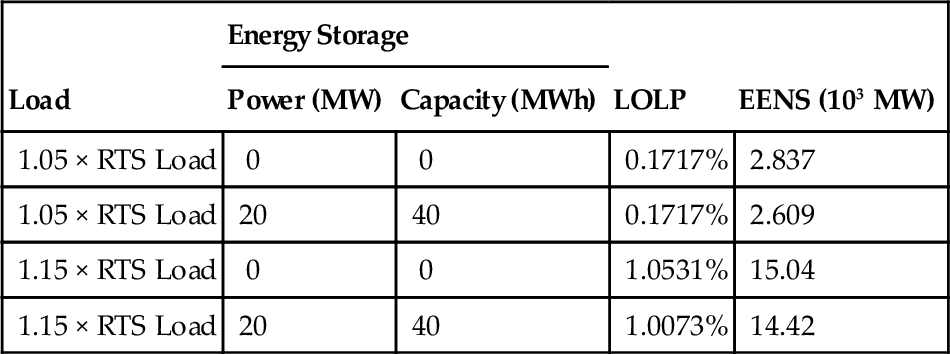
Different sizes of energy-storage and wind-turbine capacities are matched and integrated in the distribution system to form a case. The reliability results for a bulk-power system with peak load at 2992.5 MW (1.05 × 2850 MW) are shown in Table 8.2 and Table 8.3.
Table 8.2
LOLP with 105% Load Scale
| Energy Storage | WTG Capacity (MW) | ||||||
| Power (MW) | Capacity (MWh) | 2 | 10 | 20 | 30 | 40 | 50 |
| 20 | 40 | 0.1717% | 0.1717% | 0.1717% | 0.1717% | 0.1717% | 0.1717% |
| 30 | 40 | 0.1717% | 0.1717% | 0.1717% | 0.1717% | 0.1717% | 0.1717% |
| 40 | 40 | 0.1717% | 0.1717% | 0.1717% | 0.1717% | 0.1717% | 0.1717% |
| 10 | 80 | 0.1717% | 0.1717% | 0.1717% | 0.1717% | 0.1717% | 0.1717% |
| 20 | 80 | 0.1717% | 0.1717% | 0.1717% | 0.1717% | 0.1717% | 0.1717% |
| 40 | 80 | 0.1717% | 0.1717% | 0.1717% | 0.1717% | 0.1717% | 0.1717% |
| 60 | 80 | 0.1717% | 0.1717% | 0.1717% | 0.1717% | 0.1717% | 0.1717% |
| 80 | 80 | 0.1717% | 0.1488% | 0.1374% | 0.1374% | 0.1374% | 0.1259% |
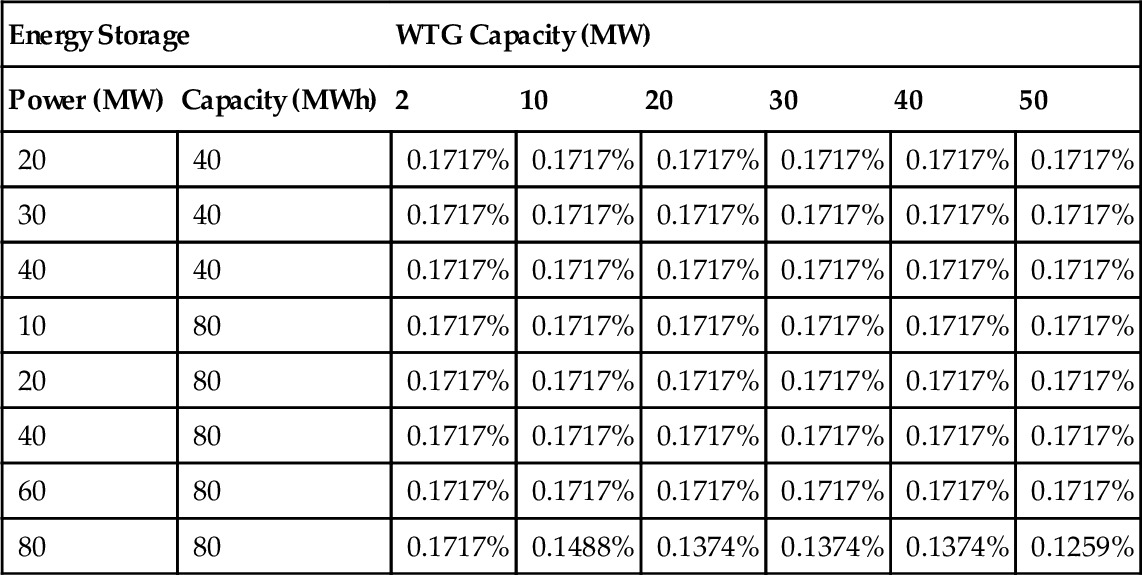
Table 8.3
EENS (103 MWh) with 105% Load Scale
| Energy Storage | WTG Capacity (MW) | ||||||
| Power (MW) | Capacity (MWh) | 2 | 10 | 20 | 30 | 40 | 50 |
| 20 | 40 | 2.609 | 2.609 | 2.581 | 2.524 | 2.524 | 2.495 |
| 30 | 40 | 2.581 | 2.581 | 2.552 | 2.495 | 2.495 | 2.495 |
| 40 | 40 | 2.581 | 2.581 | 2.552 | 2.495 | 2.495 | 2.495 |
| 10 | 80 | 2.666 | 2.581 | 2.581 | 2.581 | 2.581 | 2.581 |
| 20 | 80 | 2.552 | 2.552 | 2.524 | 2.467 | 2.445 | 2.445 |
| 40 | 80 | 2.581 | 2.581 | 2.552 | 2.495 | 2.495 | 2.495 |
| 60 | 80 | 2.581 | 2.581 | 2.552 | 2.495 | 2.495 | 2.495 |
| 80 | 80 | 2.581 | 2.426 | 2.314 | 2.257 | 2.257 | 2.169 |
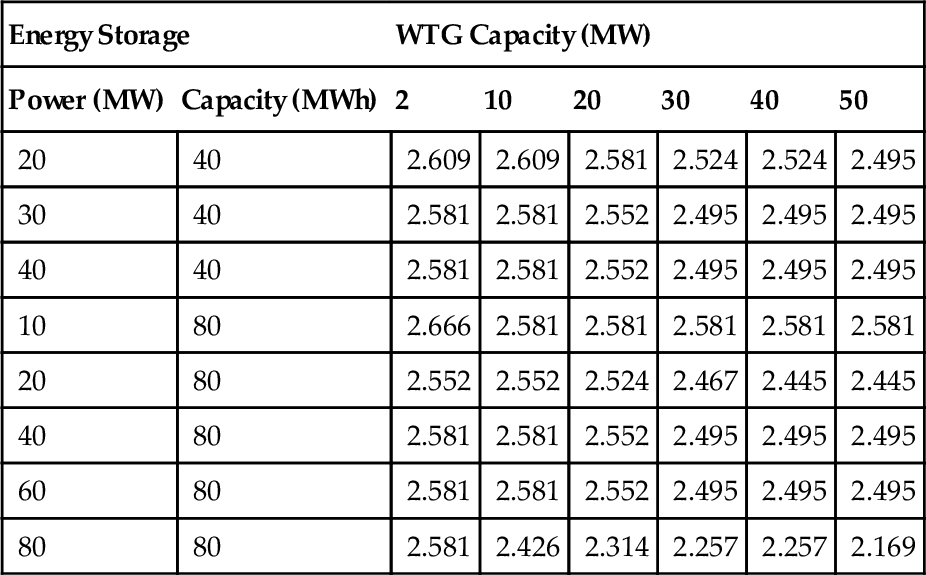
The case-study results in Table 8.1, Table 8.2, and Table 8.3 demonstrate the reliability improvement for the bulk-power system. The reliability improvement through the energy-storage integration and proposed operations is very effective. For example, in Table 8.1, for the system with peak load at 2992.5 MW (1.05 × 2850 MW), the integration of an energy-storage device alone, which has a 20 MW power rating (merely 0.67% of the 2992.5 MW peak load) and 40 MWh capacity, can improve the bulk-power system’s EENS for 8.0% ((2.837 – 2.609)/2.837 = 8.0%). With the integration of both energy-storage and renewable-energy generation, the system-reliability improvement is even more significant.
In Table 8.2 and Table 8.3, it is seen that when the energy storage has a power rating from 20 MW to 60 MW, the expansion of WTG from 2 MW to 50 MW does not improve LOLP. That is because in those events the added WTG is too small to eliminate the generation inadequacy. However, the added WTG reduces EENS from 2.609 GWh to 2.495 GWh. It is still improving bulk-system reliability and reducing customer interruption cost.
Table 8.4 and Table 8.5 present the results for the system with annual peak load at 3243 MW (1.15 × 2850 MW). With a much larger load demand, the system has the LOLP improved from 1.0073% to 0.7784%, and the EENS improved from 14.39 GWh to 13.19 GWh. Compared with the results for the 105% load-scale system, the same expansion of energy storage and WTG has a more effective impact on the reliability improvement for this less reliable system.
Table 8.4
LOLP with 115% Load Scale
| Energy Storage | WTG Capacity (MW) | ||||||
| Power (MW) | Capacity (MWh) | 2 | 10 | 20 | 30 | 40 | 50 |
| 20 | 40 | 1.0073% | 0.9959% | 0.9615% | 0.9386% | 0.8929% | 0.8585% |
| 30 | 40 | 0.9959% | 0.9844% | 0.9615% | 0.9386% | 0.8929% | 0.8585% |
| 40 | 40 | 0.9730% | 0.9730% | 0.9272% | 0.9043% | 0.8700% | 0.8242% |
| 10 | 80 | 0.9959% | 0.9844% | 0.9501% | 0.9043% | 0.8814% | 0.8700% |
| 20 | 80 | 0.9730% | 0.9615% | 0.9386% | 0.9158% | 0.8814% | 0.8471% |
| 40 | 80 | 0.9386% | 0.9386% | 0.8929% | 0.8700% | 0.8356% | 0.7898% |
| 60 | 80 | 0.9043% | 0.9043% | 0.8814% | 0.8471% | 0.8127% | 0.7784% |
| 80 | 80 | 0.9043% | 0.9043% | 0.8814% | 0.8471% | 0.8127% | 0.7784% |
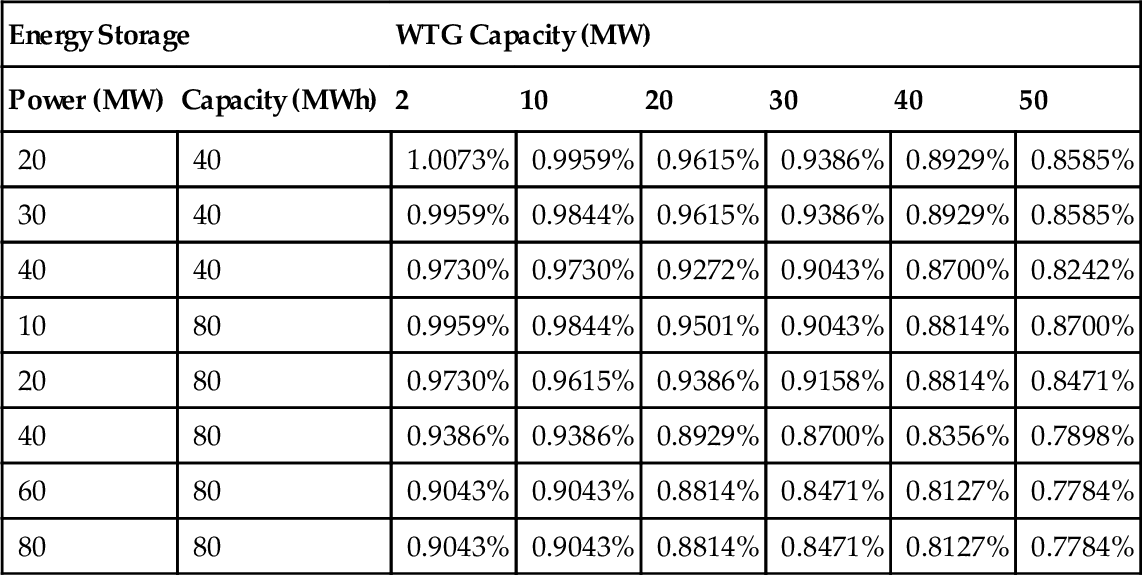
Table 8.5
EENS (103 MWh) with 115% Load Scale
| Energy Storage | WTG Capacity (MW) | ||||||
| Power (MW) | Capacity (MWh) | 2 | 10 | 20 | 30 | 40 | 50 |
| 20 | 40 | 14.39 | 14.25 | 14.10 | 13.87 | 13.77 | 13.58 |
| 30 | 40 | 14.34 | 14.19 | 14.07 | 13.84 | 13.69 | 13.54 |
| 40 | 40 | 14.30 | 14.19 | 14.00 | 13.78 | 13.67 | 13.47 |
| 10 | 80 | 14.20 | 14.10 | 13.92 | 13.74 | 13.57 | 13.53 |
| 20 | 80 | 14.05 | 13.96 | 13.80 | 13.63 | 13.56 | 13.46 |
| 40 | 80 | 14.18 | 14.06 | 13.88 | 13.65 | 13.55 | 13.35 |
| 60 | 80 | 13.98 | 13.87 | 13.77 | 13.52 | 13.40 | 13.25 |
| 80 | 80 | 14.00 | 13.88 | 13.79 | 13.50 | 13.34 | 13.19 |

As indicated in the results of the case study, the integration of energy storage within the distribution system can contribute to bulk-system reliability improvement, especially when the system is heavily loaded and becomes less reliable. However, as the energy storage is the resource owned and operated by the local distribution-system load aggregator, the system operator who benefits from it should use a compensation scheme to encourage the load aggregator for the reliability improvement benefits. The quantified reliability improvement through the proposed evaluation framework provides the basis for determining the proper compensation. If the reliability-improvement value needs to be converted to economic terms in order to determine its value, a cost/benefit analysis based on the customer-interruption cost method can be utilized. Our previous work [23] proposed an economic-evaluation method for reliability improvement based on the customer-interruption cost method.
6. Conclusion
A smart-grid communication and control infrastructure can be utilized to better manage energy storage within the distribution system. This chapter presented an operation strategy for a distribution load aggregator to utilize its energy-storage devices to better manage its energy procurement and distributed renewable-energy generation. The communication and control structure for implementing this operation strategy was also presented. The communication network enables the energy-storage coordination during a loss-of-load event in the bulk-power system. With the proposed energy-storage coordination, energy-storage integrated in the distribution system can also contribute to the bulk-power system reliability. A reliability-evaluation framework was proposed to quantify the energy-storage reliability impact on the bulk-power system. Considering the potential large-scale deployment of energy-storage devices and renewable-energy generation, the quantified study on the power-system reliability impact is crucial for the system operator to determine the value of the energy-storage integration. This work provides valuable insights on how energy storage can effectively and positively impact the bulk-system reliability. These insights can be beneficial for further studies on the planning of energy storage and renewable energy integration and expansion, cost/worthy analysis, energy-storage revenues streams evaluation, and economic feasibility analysis, etc. They can also serve to help develop more appropriate business models for energy-storage deployment.
